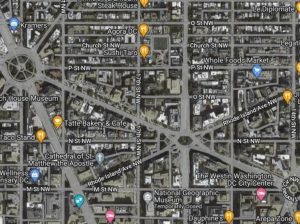1970s-era office building near Scott Circle eyed for residential conversion

Tristan Navera | The Washington Business Journal
Another older D.C. office building, this one near Scott Circle, could soon be getting a new life as multifamily housing.
Advisory Neighborhood commission 2B heard an early plan Wednesday to convert a 1970s-era, 114,000-square-foot office building at 1626 Massachusetts Ave. NW to a 157-unit residential building. The pitch came from Philadelphia-based National Real Estate Development and architecture firms Eric Colbert & Associates in D.C. and New York’s DXA Group.
The building, which was last renovated in 1995, was the longtime home of the Air Line Pilots Association International until the group moved closer to the Capitol in 2018. Its primary tenant is Johns Hopkins University’s Carey School of Business, but the school and other Hopkins’ operations in the area are moving to the renovated former Newseum building at 555 Pennsylvania Ave. NW this fall. The building’s owner is D.C.-based the Lenkin Co.
If the plan is approved, the building would be among several older downtown office properties being turned into residences at a time when city leaders are trying to attract more residents to the downtown core. With employers increasingly favoring newer building with modern amenities, hundreds of pre-1990 buildings in D.C. struggling to attract tenants could be ripe for residential conversions, according to a recent study from the real estate firm Avision Young.
Brian Buczkowski, vice president of Eric Colbert & Associates, told the commission that the building’s look would be refreshed with a new lobby and amenity space on the ground floor, as well as added green space around the perimeter. About 110 spaces in the existing garage would remain. The new design would be a more modern iteration of the columns and glass on the building now.
The building is next door to the under-construction Australian embassy and The Drake apartments, which Eric Colbert & Associates also designed.

“This would enliven the street with a lot of green space, and, hopefully, make the avenue more attractive,” Buczkowski said of the plans, which create some green buffering for the ground-floor units, as well as private terraces for penthouse units that would also be lined with trees and other landscaping.
Buczkowski said the designers are still working out what materials would be used for the conversion so he could not give a timeline for construction or price points for the eventual units, 75% of which would be one bedroom with the rest having two bedrooms.
“Any kind of construction is a ways off,” he told the commissioners.
ANC members were generally complementary of the project but it would still need to go through several more layers of review before winning their approval. The project is by-right, meaning no zoning relief is needed, but it would still need to undergo a review from the Historic Preservation Review Board because the building, while not considered historic, sits in a historic district.
The project’s developer, National Real Estate Development, had wanted to include a retail component but the zoning doesn’t allow for it, said Peter Epstein, senior development manager at the firm.
The property’s assessed value fell from $52.8 million in 2019 to an estimated $41 million for 2024, according to the D.C. Office of Tax and Revenue, which conducts building assessments a year in advance. The building owner obtained $13.6 million from the Hingham Institution For Saving in Massachusetts as part of refinancing on the building in June, according to the D.C. Recorder of Deeds.
